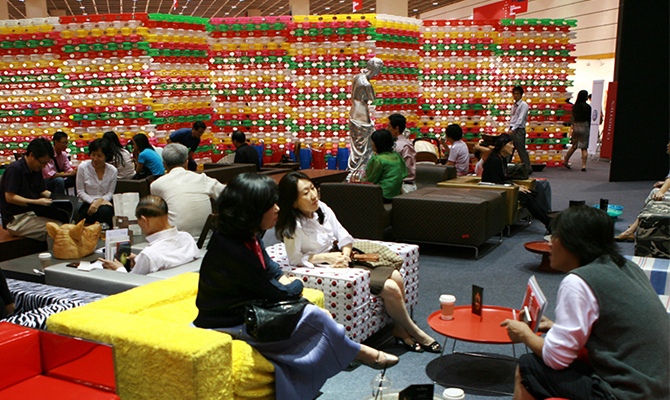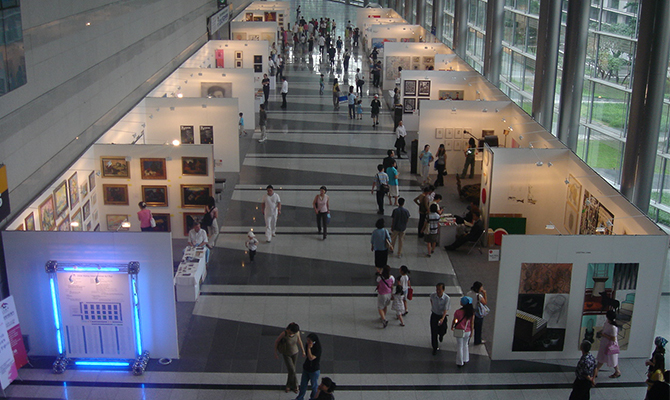
2022
Kiaf SEOUL 17 개국 163 개 갤러리, Kiaf PLUS 10 개국 73 개 갤러리로 역대 가장 많은 236 개 갤러리가 참여하여 아시아 최대 규모의 아트페어를 보여주었다. Frieze 와의 동시 개최를 통해 서울이 아시아의 가장 중요한 아트 허브로 발돋움할 수 있는 발판을 만들었다. 이전 연도 좋은 평가를 받은 “We Connect, Art & Future, Kiaf and INCHEON AIRPORT” 특별전의 두번째 에디션을 인천 제 1 공항에서 진행하였고, 2022 년 가장 중요한 화두로 떠오른 NFT 와 뉴미디어를 주요하게 다뤄 NFT 로 인지도가 가장 높은 BAYC(Bored Ape Yacht Club)와 BAGC(Bored Ape Golf Club) 특별전을 진행하였다. Frieze 와 함께 삼청 나이트를 진행하여 미술관과 갤러리, 아트센터와 함께 다양한 프로그램을 외부에서 진행하였고, 토크 프로그램에는 한스 울리히 오브리스트, 크리스토 류, 수한냐 라펠을 비롯한 국내외 미술계 저명인사들이 패널로 참여하여 심도있는 담론을 형성하였다.

2021
20 주년을 맞이한 Kiaf SEOUL 2021 은 전세계 170 개 갤러리가 작품을 선보였다. 5 일간 약 8 만 8천여명의 관람객이 방문하였으며 총 650 억원의 거래액을 달성하였다. BI (Brand Identity)리뉴얼을 통해 새로운 로고를 선보였으며, 20 주년을 기념하여 인천공항과 협업한 “We Connect, Art & Future, Kiaf and INCHEON AIRPORT” 특별전을 개최하였다. 온라인 뷰잉룸과 동시에 디스커버링 갤러리즈 (Discovering Galleries) 프로그램을 운영하였다.

2020
전세계적 대유행인 코로나바이러스-19 감염증으로 인하여 KIAF SEOUL 2020은 온라인 아트페어로 진행되었다. 웹사이트 개편과 동시에 온라인 뷰잉룸을 구축하여 139개 갤러리 4,000점 이상의작품을 선보였으며 9월 16일부터 10월 18일까지 개최되었다. 약 한 달 간의 행사 기간동안 37,000명이온라인으로 방문하였으며 740,000건 이상의 페이지 뷰를 기록하였다. 특별전《깊은 울림을 보다 – 한국근현대 추상전》 또한 온라인으로 개최되었으며, 회화, 조각 등 여러 장르에서 펼쳐지는 한국 추상미술의다향한 흐름과 독창적인 매력을 짚어주며, 한층 더 깊게 이해할 수 있는 장을 마련했다. STORIES,ARTICLES, LIVE&TALK 세가지 카테고리로 구성된 INSIGHTS 컨텐츠를 통해 참가갤러리들의 기획전시홍보, 국내외 미술 종사자들과의 온라인 대담, 컬렉터 및 작가 이야기, 퍼포먼스 등 다양한 주제의 컨텐츠를소개하였다. 온라인 플랫폼에 맞춘 모바일 도록 앱북도 출시하였다.

2019
지난해보다 130% 증가한 8만 2천 명의 관객이 방문했고, 총 거래액 310억을 기록하며 역대 최고 매출 성과를 올렸다. 특별전 《한국 근대회화, 역사가 된 낭만》은 역동적인 한국 현대미술 마켓 속에서 한국의 근대미술 작가를 재조명하여 우리 미술의 근간을 확인하는 의미 있는 자리로 기록되었다. 옛 그림이 된 우리나라 대표 그림 근대화 총 26명의 작가의 38점이 전시되어, '우리 그림, 우리 근대미술'의 아름다움을 새삼 깨닫게 하는 계기가 됐다. 아이의 눈높이에 맞춰진 프로그램들을 통해 미술에 가까워질 수 있도록 설계된 어린이 미술 전문 프로그램 ‘KIAF ART KIDS’이 다시 돌아온 해이다.

2018
특별전 《ARTIST PROEJCT》는 2018 광주비엔날레 참여 작가들이 역사성과 문화적 맥락으로 작품을 제작, 이를 KIAF SEOUL 2018과 연계하여 전시를 선보였다. 세계 미술의 중심축이 되고 있는 광주비엔날레와 KIAF SEOUL의 만남은 동시대 미술 담론과 역동하는 미술시장의 흐름을 한 자리에서 조우할 수 있다는 점에서 색다른 미술의 장이 되었다.

2017
다양한 변화가 시도된 한 해이며 총거래액이 약 270억 원을 기록하며, 역대 최고 매출 성과를 올렸다. 그간 운영되어온 주빈국 제도를 없애고, 외연 확장보다는 질적 성장에 초점을 맞췄다. 본 전시와 특별전으로 크게 나뉘던 기존 구성에 HIGHLIGHT와 Solo Project 섹터를 별도로 마련해 내실 있는 전시를 선보였다. 한국 행위예술 50주년을 조망한 아카이브 전시 《실험과 도전의 전사들(Explores of Experiment and Challenge)》와 미디어 작품을 중심으로 한 특별전 《너의 언어로 번역되지 않는 것들(Ineffable Things)》을 선보였다. 이전보다 한층 보강된 강연 및 대담 세션에서도 보이듯이 아트 페어가 미술품을 거래하는 장을 넘어 거대한 문화행사이자 국제전시로 확장되어가고 있음을 증명한 해이다.

2016
아시아 현대미술의 중심지로 떠오른 대만을 주빈국으로 선정, 11개의 갤러리를 초청하고 대만 현대미술을 조망하는 자리를 마련하였다. 해외 컬렉터 또한 사상 최대 규모인 1천 명이 초청되었다. 《스페셜 홀웨이(Special Hallway)》전의 경우 공모전 형태로 확대하여 개인을 비롯한 국내외 다양한 단체가 참여할 수 있게 하였다. 문화체육관광부가 주최하고 예술경영지원센터가 주관한 ‘코리아 갤러리 위켄드(Gallery Weekend Korea)’는 한국 현대미술의 해외시장 진출 및 국제 미술계와의 네트워크 확장을 후원하고자 2016년 처음으로 론칭한 행사로 특별히 KIAF 기간과 맞추어 개최하였다.

2015
개최지인 서울을 강조하고자 KIAF와 함께 행사명에 'ART SEOUL'을 함께 쓰기로 결정하였다. 또한 한·일 수교 50주년을 맞아 일본을 주빈국으로 선정하여 역대 최다인 20개의 일본을 대표하는 갤러리가 참가하였다. 또한 롯데백화점 후원으로 일본 현대미술의 현주소를 조망케 하는 《일본 현대미술 특별전》을 열어 나와 코헤이, 야요이 쿠사마, 요시토모 나라 등 세계 미술시장에서 주목받고 있는 일본 미술 대표 작가들의 작품을 선보였다. 아울러 전시장 내 다양한 공간을 활용하는 《스페셜 홀웨이(Special Hallway)》展은 조각 작품들 위주의 특별전 형태로 구성되었다. 여기에 최근 단색화가 인기를 끌면서 화랑들이 그간 보유했던 단색화들을 대거 선보인 것이 특징이다. 한국을 비롯해 싱가포르, 인도네시아, 일본, 중국, 호주, 홍콩의 화랑협회들이 멤버로 구성된 아시아·태평양화랑협회 연합(APAGA: Asia Pacific Art Gallery Alliance)은 각국 아트 페어의 활성화를 위해 상호협력을 도모하기로 했다. APAGA 와의 협력 관계는 향후 KIAF SEOUL을 통해 “One Asia”를 만들어 가기 위한 초석이 되었다.

2014
역대 최다 약 8만 8천여 명의 관객이 방문하였으며 22개국이 참여하는 기록을 세웠다. 동남아시아가 주빈국으로 선정되어 《동남아시아의 현대미술과 그 시장(The State of Southeast Asian Contemporary Art and Its Market)》展이 열렸으며 싱가포르, 인도네시아, 말레이시아, 미얀마, 캄보디아, 필리핀 6개국의 13개 갤러리가 참가하였다. 국내 특별전 《Art Flash: Art for Fifth Sense》에서는 관람자의 움직임 및 터치에 의해 직접 반응하고 소통하는 Interactive Media Art 작품으로 관람객들에게 미술의 다양성을 소개함으로써 문화융성을 이끌어 낼 수 있는 원동력이 되었다.

2013
2013년은 독일과 한국에게 매우 특별한 해로 양 국가의 외교적인 관계가 시작된 지 130년을 기념하며 1만 명이 넘는 광부, 간호사를 독일로 파견한 지 50년을 맞이한 해이다. 이 두 행사는 한국과 독일의 역사에 있어 모두에게 중요한 것이기에 그 의미를 기념하고자 독일을 주빈국으로 선정하여 《미술시장–미술대중(Art Market–Art Public)》 특별전을 선보였다. 국내 특별전 《Art Flash: 우리가 백남준에 대해 알고 있는 두, 세 가지 것들》에서는 현대미술사에 지대한 영향을 미친 백남준에 대한 통찰과 영감 어린 서사가 결합하여 빚어내는 시적(詩的) 비전을 보여준다. 또한 세계 유명 아트페어를 소재로 작업하는 베를린의 사진작가 가브리엘 하이테커의 특별전 《가브리엘레 하이데커 아트 어페어 사진전(Gabriele Heidecker Art Affiars)》을 열어, 세계 각지 아트페어의 다양한 모습들을 담은 사진들을 전시하였다.

2012
한국-라틴아메리카 수교 50주년을 맞이하여, 세계 미술 시장의 별로 떠오르고 있는 라틴아메리카가 주빈국으로 선정되었다. 특별전 《세계 미술시장의 떠오르는 별, 라틴 아메리카 현대미술(Contemporary Art of Latin America, The Rising Star of the Global Art Market)》을 통해 혼재된 문화적 배경 속에 새로운 형태로 발전시킨 라틴 아메리카 미술의 현재를 발견할 수 있는 자리가 마련되었다. 또한 전년도에 이어 《Art Flash》 특별전에서는 20,30대 젊은 한국 작가들의 작품을 소개하여 보다 독립적인 문화 환경 아래서 한국 현대미술의 주체적 정체성 발현 가능성을 단편적으로나마 가늠해 보는 계기가 되었다.

2011
20대 관람객이 예전에 비해 두 배 이상 늘어났다. 주빈국으로 호주가 참여하여 특별전 《고립에 대한 저항: 호주의 미술 판매(Against Insularity: Selling Art in Australia)》을 선보였다. 또한 국내외 미술시장에서 활발히 활동하는 한국 미디어 작가들을 선정, 회화 중심의 아트페어에서 벗어나 장르의 다양성을 제시하는 《Art Flash: Media & Installation Art》 특별전을 기획하였다. 미디어 아트, 설치미술, 키네틱 아트를 중심으로 구성되었으며 화랑이 추천하는 작가의 독립부스 기획을 통해 작가의 작품 성향을 집중 조명하도록 설계하였다.

2010
주빈국으로 선정된 영국의 현대미술 현황과 쟁점들을 살펴봄으로써 당시 현대미술을 돌아보는 계기를 마련하였다. 특별전 《Creative Power: Korean Media Art》에서는 21세기를 대표하는 장르라 할 수 있는 미디어 아트의 과거와 현재를 되짚어 보았다. 백남준의 비디오 아트에서 시작되어 설치 및 조각 등 여러 예술 장르와 결합한 한국 대표 작가들의 작품을 통해 당시 국내 미디어 아트와 그 속에 잠재되어있는 창의력 발현의 한 일면을 살펴볼 수 있었다.

2009
인도 현대미술의 동향을 포괄적으로 보여주는 특별전 《실패한 계획》 및 전시 연계 프로그램들을 통해 인도 미술의 우수성과 잠재적 발전 가능성을 알리는 발판을 마련하였다. 또한 국내 특별전 《모던보이 모던걸 – 한국 현대미술과 모더니즘, 모더니티》를 통해 1920년대부터 1950년대 중반 이후까지 한국미술의 현대화 과정과 흐름 속에서 ‘현대성’이란 무엇인지를 살펴보았다. 어린이들이 자연스럽게 미술과 친해질 수 있도록 구성한 어린이 미술 전문 프로그램인 ‘키즈 인 키아프(KIDS in KIAF)’가 열린 첫 해이기도 하다.

2008
218개의 갤러리가 참가하여 역대 최다 기록을 세웠다. 스위스가 주빈국으로 선정되었으며 특별전 《What You Get Is What You Want》에서 선보인 젊은 작가 3인의 작품을 통해 스위스 정체성에 대해 이야기해보았다. 국내 특별전 《달의 정원(A moonlit Garden)》에서는 국내외 미술무대에서 활발한 활동을 하며 한국미술의 중추적 역할을 하고 있는 국내 중견 작가 10인의 작품들을 통해 한국미술의 대표성을 보여주었다

2007
전년보다 배로 커진 규모로 작품들의 총거래액이 175억이 넘는 대형 아트 페어로 성장하였다. 총 208개의 갤러리가 참가하였으며 주빈국으로는 스페인이 선정되었다. 총 14개의 스페인 갤러리들이 참여한 《스페인 신진작가 특별전(New Contemporary Art from Spain: A Proposal)》과 한국 신진작가전 《Something Mr. C Can’t Have》을 통해 진보적인 흐름을 이어 나가고 있는 젊은 작가들을 소개함으로써 미술시장의 흐름과 현장의 흐름의 폭을 좁히고 국내외 콜렉터 및 미술 애호가들에게 보다 전문적인 현장의 흐름을 접할 수 있는 기회를 마련하였다. 또한 스페인 독립영화 다섯 편을 소개하는 스페인 영화제 및 다양한 학술 프로그램들이 구성을 이루었다.

2006
행사 규모가 120% 커지는 현상을 보였다. 한·불 수교 120주년 기념 특별전 《파리–서울(Paris–Seoul)》이 기획되었으며 연계 포럼 등을 통해 KIAF가 아시아와 미국 시장을 넘어 세계 시장으로 도약하고 있음을 보여주었다.

2005
독일과 한국 미술 교류의 해를 맞아 독일의 7개 화랑을 포함한 20여 개 유럽 최상급 화랑이 참여하였다. 아리 드 크네흐트(Arie de Knecht) 소장품을 중심으로 한 《독일 현대미술전(German Contemporary Art)》과 한·독 작가들의 《디지털 미디어 아트전(Korea-Germany Digital Media Art)》을 통해 유럽 현대미술에 대한 이해를 더할 수 있는 자리를 마련하였다.

2004
특별전 《일본 현대미술(Contemporary Japanese Paintings)》展과 《디지털 아트 리미티드(Digital Art Limited)》展은 동시대 미술의 흐름과 쟁점을 확인시켜 주는 기획전이 되었다. 《일본 현대미술(Contemporary Japanese Paintings》전은 현재 왕성한 활동을 펼치고 있는 일본 현대 화가들의 작품들을 펼쳐 보인 특별전으로 특히 전시 작품을 회화로 한정했다는 점에서 동시대 일본 회화의 면면들을 살필 수 있는 좋은 자리가 되었다. 《디지털 아트 리미티드(Digital Art Limited)》展은 디지털 및 미디어를 이용한 작품들의 현 위치를 살펴볼 수 있는 또 다른 기회를 제공하였으며, 싱글 채널 비디오, 인스톨레이션, 인터랙티브 아트 등 미디어 아트의 다양한 경향을 소개하였다.

2003
최초로 서울 COEX에서 개최되었다. 첫 해 특별전의 연장선으로 한·중·일 조각展 《동방의 빛 II(Light of the East II)》을 선보였으며 중국 체제 권력과 예술 교육계의 규칙에 온건한 반기를 든 중국 현대 작가들의 도전과 실험을 담은 《중국 현대 회화전(Today’s Chinese Painting)》 또한 특별전으로 기획되었다. 또한 학문적 깊이와 정보의 엄밀함을 확보하는 방안으로 다양한 학술 세미나 프로그램들을 선보이기 시작하였다.

2002
한국 미술의 저변 확대와 국제적인 경쟁력을 높이기 위해 한국국제아트페어(Korea International Art Fair 이하 KIAF)가 2002년 처음 부산 BEXCO에서 문을 열었다. 한국에서 열린 최초의 국제 아트페어이자 국내 최대 규모의 미술 축제로, 한국 미술을 대표하고 시장을 선두 하는 역할을 하며, 동시대 현대 미술의 가치를 발견하고 미술시장의 흐름을 확인할 수 있는 국제 아트페어로서의 역할을 하고자 기획되었다. 첫 해의 특별전으로는 한·중·일 현대미술 작가展 《동방의 빛(Light of the East)》을 선보였다. 단순히 3국의 모음을 넘어 동북아시아의 상호부조와 협력이라는 실험 속에서 새로운 유토피아를 추구해가며, 인류사적인 희망을 발견하고 제시하고자 기획되었다.

